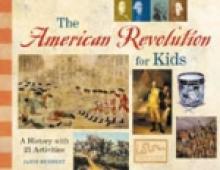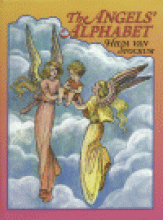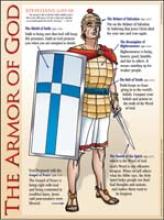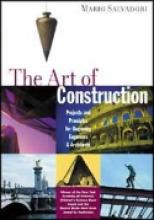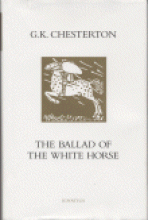No name
The American Revolution for Kids, A History with 21 Activities
Sepia and black and white illustrations
The Angel's Alphabet
The Annotated Innocence of Father Brown
In this book of the first twelve Father Brown mystery stories, editor Martin Gardner has looked up all the obscure references, which Chesterton frequently threw into his stories - mentions of people popular at the time whom we're no longer familiar with, use of obscure of obsolete English words from 100 years ago, slang expressions from 100 years ago - these are explained to the reader's satisfaction in the numerous footnotes by the helpful Mr. Gardner.
By reading the annotated version of the story, the Father Brown mysteries come alive for young people. And I must note that since several mysteries in the series refer to murders, even a decapitation, I would recommend this book for ages 13 and up.
The Father Brown mysteries are some of Chesterton's most enduring work. In general, people may not remember that Chesterton wrote such classics as Orthodoxy and The Everlasting Man. However, they may recall him as the author of the Father Brown Mysteries, and so it is appropriate to start reading these mysteries first. These mysteries first appeared serialized in various magazines of the times in England. This in part explains the obscure references to people of that day. The other part of the explanation is that Chesterton considered himself a journalist, mainly writing words for newspapers, which would be thrown away shortly after reading. Never did Chesterton imagine that his work would be known and loved 100 years later.
If you are interested in introducing your teenager to the works of G.K. Chesterton; or if youare looking for some good fiction for your teen; or if you wanted to start reading Chesterton yourself and didn't know where to begin, I recommend this book.
originally appeared in Heart and Mind Magazine, Spring 2005 - used with permission
The Armor of God
The Armor of God pictures a soldier in full battle gear - sword, shield, helmet, etc. - with descriptions explaining their figurative meaning according to Ephesians 6:10-18: Finally, be strong in the Lord and in the strength of his might. Put on the whole armor of God, that you may be able to stand against the wiles of the devil. For we are not contending against flesh and blood, but against the principalities, against the powers, against the world rulers of this present darkness, against the spiritual hosts of wickedness in the heavenly places. Therefore take the whole armor of God, that you may be able to withstand in the evil day, and having done all, to stand. Stand therefore, having girded your loins with truth, and having put on the breastplate of righteousness, and having shod your feet with the equipment of the gospel of peace; above all taking the shield of faith, with which you can quench all the flaming darts of the evil one. And take the helmet of salvation, and the sword of the Spirit, which is the word of God. Pray at all times in the Spirit, with all prayer and supplication for all the saints. This attractive chart is great in a classroom or on a bedroom wall. The back of the chart includes four reproducible worksheets. Available laminated or unlaminated.
My son Gus (age 8) says: "I think that it is especially good for boys."
Update March 2024: This "Catholic Edition" features Bible quotes using the NAB rather than the NIV. Ascension Press used to carry these wall charts but no longer does. However, they are still being published (see the box at the top of this review for details).
Binding details: 19 3/8" x 26" Wall Chart
The Art of Construction
Reading Level: Ages 9-12
The Art of Construction (originally published in 1979 under the title Building: The Fight Against Gravity) is one of the finest examples of books that help children understand principles of science as applied to real life situations - in particular buildings and making sure that they stay up in spite of gravity and natural disasters.
Children are introduced to important concepts like "tension" and "compression" with simple hands on exercises to help understand and remember them. Most chapters include a somewhat-more-involved construction project to teach these principles (and have a lot of fun in the process). Numerous illustrations make concepts and clearer and aid in understanding the building projects.
The text is very engaging and easy-to-understand. We've found it ideal as a read-aloud with a group. Our co-op has been using it somewhere in the 2nd to 4th grade range, although it could certainly used by much older students (all the way through high school would be reasonable). The engineer dads in our co-op have been very impressed with the book and the concepts the children study.
The chapter titles are as follows (and give you a little glimpse of the content and style):
- From Cave to Skyscraper
- Building a Tent
- What is a Beam?
- What do We Build Structures With?
- The Floor of Your Room
- A Steel Frame...Made Out of Paper
- The Part of the Building You Don't See
- What Tornadoes, Earthquakes and Changes in Temperature Can Do
- How to Fight Tornadoes and Earthquakes
- Ropes and Cables
- Sticks and Stones
- Strings and Sticks
- Shape and Strength
- Barrels, Dishes, Butterflies, Bicycles Wheels and Eggs
- Balloons...and Back to the Tent
"If you had one of your friends put your hands on each other's shoulders and move your feet away from each other, you will become a full arch and feel compressed by each other's weight. But if your shoes slip on the floor and you begin to slide apart, the arch will collapse. Its ends must be firmly anchored to prevent it from spreading apart." (pg. 15)
"The best way to understand how the frame of a building works is to build one. A good model of a steel frame can be built with paper, provided we first build the separate elements of the frame: the columns, the beams, and the floors. A column should not take too much floor room, but must be strong enough to carry the compressive loads without buckling under them. A column buckles, that is, bends under compression along its axis, if it is too thin. Take a plastic ruler, stand it up, and push downward on it: there comes a point when the ruler will bend out." (page 39)
"The purpose of a building's structure is to guarantee that the building will stand up under all the loads and forces acting on it: the weights, the pressure of the wind, the forces due to temperature changes, and, possibly, the shaking caused by earthquakes. The builders want to make sure that the building will not collapse, and they hope it will not even be damaged, since in the first case it may kill people and in the second it may be costly to repair. They also want to make sure that the building will not move around. If a house were to slide down the slope of the hill it is built on, or if a skyscraper were to be toppled by the wind, the buildings would have failed their purpose, even if their structures might sometimes ed up undamaged." (page 57)
This is one of the books that I want to be sure each of my children have a chance to study sometime during their school years. Highly recommended!
The Assisi Underground
The Ballad of the White Horse
The Bard of Avon
This picture book biography of William Shakespeare does not dwell at all with the issue of the great playwright's religious affiliation.
The Bears on Hemlock Mountain
Based on a tall tale described by the State Archivist for the state of Pennsylvania, this delightful story about an eight-year-old boy will appeal to boys and girls alike. The use of repetition and a rhythmic sentence structure make the story an excellent choice for a read-aloud for any age group. It is also suitable as a first "chapter book" for a newly-independent reader.

